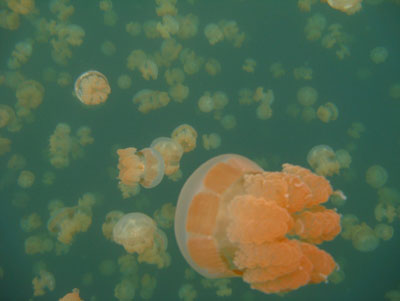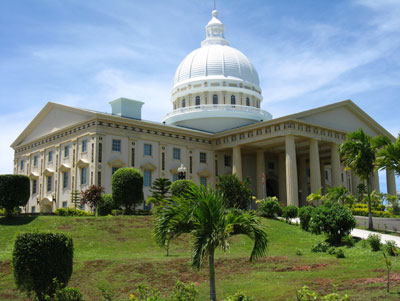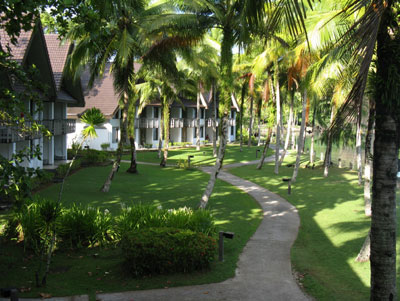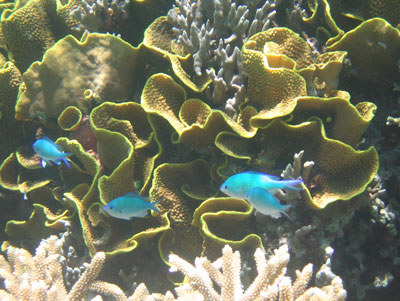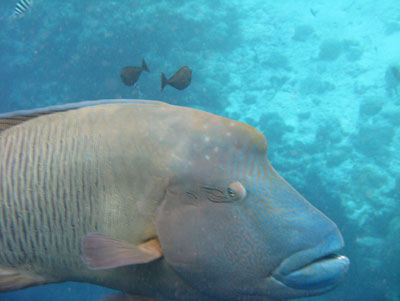Palau — A snorkeler's dream destination
Larry Taylor, Fullerton, CA. Photos by Gail Taylor
Palau: my wife, Gail, and I had been there before and jumped at the chance to return. We were booked on a cruise from Papua New Guinea that ended in Palau, and we decided to stay over for three days, in May ’08.
Not a lot of American travelers know about this unspoiled travel destination, but just ask avid divers or snorkelers. If they haven’t already been there, they probably will tell you Palau is at the top of their list of must-go spots.
About Palau
Considered a part of the region of Micronesia (not the nation), Palau is an archipelago of 343 islands in the Western Pacific. It is a country with more than 20,000 citizens, about 70% of whom live in the state of Koror, where travelers usually stay.
Off Koror, the main attraction is the Rock Islands, approximately 300 islets protected by a huge barrier reef. It’s an underwater paradise. Fans of the TV show “Survivor” will recognize this spot, as it has been used twice as a location, most recently in early 2008.
Upon disembarking from our cruise, we arranged for a day tour to see spots we missed on our previous visit. The itinerary included a visit to Palau’s largest island, Babeldaob, situated across a causeway from Koror. The country, having built a wide new road, hopes to increase tourism to this lush green area.
Things to see
Starting off in Koror, we visited its unique aquarium, where the exact environments for the different types of marine life there have been re-created. This has become one of the country’s most popular land-based attractions for tourists and Palauans alike.
We observed exhibits with green sea turtles, nurse sharks, whitetip sharks and groupers. In addition to coral reef inhabitants, the aquarium exhibits animals and plants found in mangrove and sea grass ecosystems, seahorses foremost among them.
We also took in the exhibits at the Belau National Museum. On display were artifacts from the islands, including ancient money, now used as jewelry.
Next was Babeldaob, where we took the Jungle River Boat Cruise (phone +680 488 1188 or e-mail rivercruise@palaunet.com) on the Shimizu River. We set out down the calm waterway to our destination for the day, an ancient Palauan village historical site. We cruised through the lush green rainforest foliage, spotting a variety of birds along the way.
We were told there were crocodiles there and suddenly we saw a big one. We knew the croc was expecting us when the boatman held a piece of meat on a pole and the animal jumped some five feet out of the water to grab it.
After our river cruise ($75 per adult, including lunch), we sauntered along a pathway admiring the interesting collection of tropical plants before stopping for a typical Palauan bento box picnic provided in one of two open-air “summer houses.”
We went on to Melekeok to see the highly publicized, imposing capitol, which sits by itself on a rise with nothing around it but rolling green hills. The architect wanted to make something unique to Palau; however, the Palauans wanted it to look like the US capitol. So there it was, with large columns standing in front of a stone façade etched with Palauan designs — odd but unique and lovely.
We continued on toward the Wonderpool Waterfall, where we were scheduled for a 40-minute hike to a spectacular view. Unfortunately, the road was full of mud holes from a recent rain. After getting stuck and having to work our way out, the driver turned around and a change in plans took us to nearby Tabecheding Waterfall, a lovely spot that was easily accessed.
Underwater wonders
By late afternoon we were back in Koror, where we checked into the highly rated Palau Pacific Resort. We took a dip off the wide sand beach before watching the beautiful sunset from our balcony.
The following day proved to be the highlight of our stay, snorkeling ’til we dropped on a Sam’s Tours snorkeling trip through the Rock Islands ($120 including lunch, beverage and hotel transfers). Sam’s picked us up early in the morning at the resort’s dock and we headed out.
A collection of foliage-covered, rounded limestone formations, these islands are undercut by wave action; many seem to float on the water’s surface. Channels wend their way among the islands, tunnels lead to secluded lagoons, and paths lead to landlocked lakes fed subterraneanly by the sea.
Within a short time we were in the water, overwhelmed by the dazzlingly colorful corals. Over 500 types of hard and soft varieties thrive there. We saw fish — large, medium and small — in almost staggering numbers and an array of rainbow hues.
With over 1,400 species of fish, Palau was named “Number One Underwater Wonder of the World” by CEDAM, a group of marine scientists and conservationists.
Swimming with the fishes
Most of the snorkeling spots in the area are given colorful descriptive names, like Giant Clam Beach, Lolita’s Coral Gardens and Mandarin Fish Lake, the latter being where the exquisitely beautiful mandarin, decorated in an oriental design of green, blue and orange, can be found.
Our stop at Shark Alley, which was full of blacktip sharks, was a highlight. We saw many 4- to 6-footers. Thankfully, they don’t attack people. Pilot fish swam in front of them, and remoras were attached underneath by sucker-like disks on top of their heads — really a sight to see. We also saw some cute little damselfish. While the sharks did stay away, my wife was nipped on her ankle by a damselfish.
Most snorkeling expeditions take in Jellyfish Lake, as did ours. Closed off from the ocean, the lake has formed a unique environment where jellyfish have no enemies and no need to sting, resulting in their having very small stinger cells harmless to humans. Swimming among the graceful jellies was like gliding through a porous, pinkish-gold curtain.
From there we went to Giant Clam Beach, where about a dozen clams up to three feet in size and in various colorful shades were lined up along the bottom of the sea.
Historical sites
Archaeology is also a consideration on most excursions. At one point we got off the boat and hiked up to a site where the people of nearby Yap quarried stone to make their unique money, known as rai. Used since ancient times for barter, these large, donut-shaped disks, usually made of calcite, measured up to 12 feet in diameter.
There are also numerous relics from WWII to see on the islands. During the war, the Japanese thought that Palau would be a prime target for an Allied invasion. Consequently, the islands were heavily fortified.
Our captain from Sam’s had been working in the area for some 30 years, so he knew all the places of interest. He showed us bunkers and gun emplacements on the shore, and we snorkeled over sunken landing crafts and Zero airplanes. This is the perfect place for WWII history buffs.
Resort relaxation
On our final day, tired from the previous day’s strenuous activities, we decided to stay at the resort and snorkel off the beach there. Right away, we encountered a good-size octopus, which we followed for a half hour, watching as he changed colors from coral red to rock gray. Among an array of fish, we came upon a 6-foot-long sea snake making his way into a rock crevice.
Later we spent a little time exploring the grounds of this deluxe resort which attracts an international group of visitors, many from Taiwan and Japan only a few hours away. Besides underwater sports, activities available to guests include windsurfing, sailing and kayaking.
The resort grounds include a large swimming pool overlooking the ocean plus two lighted outdoor tennis courts and a well-equipped fitness center. The resort also has a PADI 5-star dive center. Two restaurants on site feature Pacific Rim cuisine, Micronesian specialties and local seafood.
If you go
Practically all Palauans speak English in addition to their own unique language, and they go out of their way to be helpful. We took offered advice and found two excellent restaurants, Carp, with authentic Japanese food (not to mention, for the adventurous, the local fruit bat soup), and The Taj, featuring great Indian cuisine. Meals cost around $25 each, including drinks.
The dollar goes far in Palau. Taxis and meals are bargains. Tourism is increasing rapidly, so look to Palau while it’s still laid-back and peaceful and before flocks of tourists arrive in coming years — and, believe me, they will.
For more information on Palau, contact the Palau Visitors Authority (fax +680 488 1453 in Koror or visit www.visit-palau.com).
Various types of diving and snorkeling tours, as well as land tours, are offered by Sam’s Tours (phone +680 488 7467, www.samstours.com) at reasonable prices.
At the Palau Pacific Resort (phone 866/539-8430, http://palauppr.com), rack rates start at $350, but check their website for specials, which can begin at around $255.


